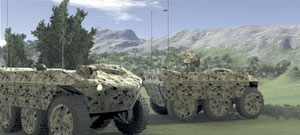Test Center Forges Network-Centric Future
 |
The Thales Battlespace Transformation Center, known as the Battlelab, is a virtual entity that combines the company’s research and analysis facilities to develop new programs. Its advanced modeling and simulation capability allows customers, such as the French army, to test new technologies and operational concepts like these prototype network-centric combat vehicles. |
Europe’s armed forces are using virtual reality to develop and integrate new technologies. Consisting of several networked facilities operating as a single entity, this research and design capability allows defense firms and their customers to test how systems operate before funds are committed for acquisition and production. This virtual testing center uses sophisticated modeling and simulation functions to create operational and training methodologies.
Weaving together new and legacy equipment and software into a single system is a task fraught with unexpected pitfalls. Although technologies may behave under laboratory conditions, real-world testing or operational use often exposes a variety of unforeseen complications. But with more powerful computers, it has become possible to test new capabilities in synthetic environments. Advanced simulation technology permits an accurate and economical means to model system integration. By linking a number of these facilities into a single network, the testing and benchmarking process can be accelerated and opened to more participants.
An example of this approach is the Thales Group’s Battlespace Transformation Center. Launched at the beginning of the year, it is designed to implement the company’s vision for transformation and network-centric warfare, explains Martin van Schaik, the center’s vice president and director, who is based in Colombes, France. Known as the Battlelab, the center is a virtual entity that links all of the company’s divisions into a coherent research and analysis partnership to study and launch new programs. The effort also has a business development component that interfaces with customers and other companies to share expertise and resources. “Ultimately, we’re not going to do this all by ourselves. We would like to, but it’s not realistic,” van Schaik observes.
Van Schaik notes that the company’s newly formed Land and Joint Systems Division (SIGNAL, September, page 42) has an operational analysis and architecture group responsible for developing interoperable technologies. This and other Thales business units are working with European and North American defense firms to ensure that any systems developed through the Battlelab can operate in a joint and multinational environment.
The center’s operational analysis and architecture components are important tools for outlining a new technology’s full potential. “You can’t wait anymore for customers to derive new concepts because they don’t fully understand the possibilities of the technology anymore. On the other hand, we cannot come up with new architectures if we don’t know what the operational concepts are. One way or another, we have to put our hands together to develop new solutions and criteria—for example, the rapid response force, which is NATO’s first materialization of transformation,” van Schaik explains.
A major priority at the center is developing and testing new operational concepts for NATO’s transformation efforts, says van Schaik. He adds that transformation and network-centric warfare are philosophies and that there is a need to apply creative solutions to them. “It’s one thing to analyze an existing system and have all our experts simulate it and number crunch it. The creative process of coming up with a new, nontraditional solution that significantly improves operational effectiveness—that’s a whole different game,” he observes.
Although this need has existed for some time, there were not many capabilities available to help governments develop new operational concepts and technologies until the Battlelab became available. Van Schaik notes that although many firms and government organizations have training systems and virtual simulators, they do not test operational concepts. “We don’t want to do that. We want to connect technology and architectures with concepts of operation. That combination is absolutely essential to make things progress,” he says.
The Battlelab has three main goals. Its first objective is to demonstrate how the company’s legacy equipment can be connected into command chains. The second goal is modeling new systems and approaches with customer participation. For example, sensors and communication systems can be studied for military efficiency or tested in alternative scenarios to examine connectivity and configuration capabilities, he says. Once a device or application has met its requirements, the center’s third function is to work with customers to create new operational and training doctrine for it.
Van Schaik adds that the center’s three components also serve as preparation, virtual testing and evaluation functions. He notes that the Battlelab can integrate real hardware and systems as well as experimental ones. “You start with simulation, and later on you connect real systems into it to verify performance. In the end, we will also be able to connect to real experiments on the battlefield and use it [the laboratory] as an evaluation tool,” he says.
The Battlelab was demonstrated at this summer’s Eurosatory exhibition in Paris. Van Schaik notes that a version of the Battlelab system already has been delivered to the French Ministry of Defense. The demonstrator featured a scenario where a fully networked, mechanized platoon had to secure a town using future French army combat vehicles and unmanned aerial vehicles (UAVs). The simulation allowed commanders to test new technologies and develop new doctrine for them.
Because it can be used as a combat simulator, the scenario allowed the user to define the operational situation and threat levels, conduct the engagement and analyze the effectiveness of the operation. A high degree of complex behavior can be studied and modeled through the laboratory. In this particular scenario, the movements of individual civilians are tracked as they interact with blue and red forces.
Operators using the Battlelab are presented with several monitors showing what their sensor systems can detect in the simulation. The underlying software system also models legacy and prototype navigation, target acquisition and battle management systems, he says. The simulation architecture allows the entire force to be networked. This can provide multiple views of the enemy through different sensor and reconnaissance systems. Updated information is then sent to the unit’s commander in real time. Van Schaik adds that the virtual exercises can be repeated to collect more data or to modify technologies and doctrine for optimal performance. These results can cause a complete redefinition of a system’s functions. This information can then be formatted to provide training for the new concepts defined by the tests, he says.
Although the Battlelab’s core technology was available by the early 1990s, years passed before all of its possibilities became evident. “Ten years ago, at several locations inside our group, we started to use virtual reality and simulation tools to demonstrate basic operational effectiveness. But it was very local and for dedicated events,” van Schaik explains.
But improved simulation technology led to more powerful modeling and information sharing capabilities across the company. In 2003, Thales officials realized that they had a large but fragmented simulation, research and analysis capability. “The only thing we didn’t do was put it into context and connect it. It was all isolated efforts, and we definitely didn’t demonstrate command chains or [run demonstrations] for multiservice or collaborative operations between naval, land and air forces,” he says.
Thales’ Battlelab is the sum of all these different research components working together. Van Schaik emphasizes that it is a completely virtual operation consisting of nodes located at Thales facilities across Europe. This distributed architecture allows a variety of methods for modeling and testing, from purely virtual exercises to operations using real units such as ships from the Royal Netherlands Navy or British and French UAVs in joint exercises.
Web Resources
Thales Land and Joint Systems Division: www.thalesgroup.com/ga/business_zone/defence/land_joint.htm




Comments